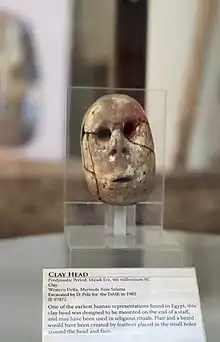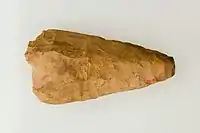Merimde culture
The Merimde culture (also Merimde Beni-Salame or Benisalam) (Arabic: مرمدة بني سلامة) was a Neolithic culture in the West Nile Delta in Lower Egypt, which corresponds in its later phase to the Faiyum A culture and the Badari culture in Predynastic Egypt. It is estimated that the culture evolved between 4800 and 4300 BC.[1] Merimde also refers to the archaeological site of the same name.
 Merimde clay head, Predynastic Period, Maadi Era, 4th millennium BCE. This is one of the earliest known representations of a human head in Egypt. | |
| Geographical range | Egypt |
|---|---|
| Period | Neolithic |
| Dates | c. 4,800 BC — 4,300 BC |
| Preceded by | Faiyum A culture |
| Followed by | Amratian culture |
Archaeological work
The culture was concentrated around the main settlement site of 25 hectares in the West delta of the Nile in Lower Egypt 45 km northwest of Cairo. The site was discovered by German archaeologist Hermann Junker, who excavated 6,400 m² of the site during his West Nile Delta expedition in 1928.[2]
Later excavations in the 1970s performed by the Egyptian Antiquities Organization and the German Institute of Archaeology led to the establishment of the stratigraphical sequence.[3]
Characteristics
Merimde shows a sequence of occupations which lasted almost a millennium according to some estimates. While Junker identified three sequences, others such as Joseph Eiwanger established in 1977 that there are five with significantly different levels of development. Artifacts such as ceramics were quite primitive during phase I – a phase characterized by a light occupation. Eiwanger documented that storage areas appeared during phase II when the intensity of the occupation increased.[4]
Economy

Archaeological evidence suggests that the Merimde economy was dominated by agriculture although some fishing and hunting were practiced to a lesser degree. The settlement consisted of small huts made of wattle and reed with a round or elliptical ground plan. Merimde pottery lacked "rippled marks".[5]
Burials
Burials had unique characteristics, different from those practiced in Upper Egyptian Predynastic Egypt and later Dynastic Egypt. There were no separate areas for cemeteries and the dead were buried within the settlement in a flexed position in oval pits without grave goods and offerings.[6]
In the time of the Maadi culture, the place was used as a cemetery.
Excavations of Merimde burials have yielded a number of skeletons, chiefly those of females. The fossils are generally taller and more robust than later predynastic Egyptian specimens. In this regard, the Merimde skeletons are most similar to those associated with the Tasian culture. Furthermore, although the Merimde crania are dolichocephalic (long-headed) like many of the other predynastic skulls, they have a large and wide vault like the Tasian crania. Skulls excavated from Badarian, Amratian sites tend instead to be smaller and narrow.[7][8]
 Grain from Merimde, MET
Grain from Merimde, MET Hand ax, Neolithic Period, Buto–Merimde–Maadi, c. 4500–4000 BC. Western Delta, Egypt
Hand ax, Neolithic Period, Buto–Merimde–Maadi, c. 4500–4000 BC. Western Delta, Egypt
Relative chronology
See also
| Periods and Dynasties of Ancient Egypt |
|---|
|
All years are BC |
|
See also: List of Pharaohs by Period and Dynasty Periodization of Ancient Egypt |
External links
References and notes
- Bogucki, Peter I. (1999). The origins of human society. Wiley-Blackwell. p. 355. ISBN 1-57718-112-3.
- Hoffman, Michael A. (1980). Egypt before the pharaohs. Taylor & Francis. p. 168. ISBN 0-7100-0495-8.
- Bard, Kathryn; Steven Blake Shubert (1999). Encyclopedia of the archaeology of ancient Egypt. Routledge. p. 501. ISBN 0-415-18589-0.
- Shaw, Thurstan (1995). The Archaeology of Africa: Food, Metals and Towns. Routledge. p. 212. ISBN 0-415-11585-X.
- Brewer, Douglas J.; Emily Teeter (2007). Egypt and the Egyptians. Cambridge University Press. p. 35. ISBN 978-0-521-85150-3.
- Hoffman - pp. 174.
- Forde-Johnston, James L. (1959). Neolithic cultures of North Africa: aspects of one phase in the development of the African stone age cultures. University of California. p. 58. Retrieved 16 June 2016.
- Journal of the Anthropological Institute of Great Britain and Ireland, Volume 65. Anthropological Institute of Great Britain and Ireland. 1935. p. 27. Retrieved 17 June 2016.
- Liverani, Mario (2013). The Ancient Near East: History, Society and Economy. Routledge. p. 13, Table 1.1 "Chronology of the Ancient Near East". ISBN 9781134750917.
- Shukurov, Anvar; Sarson, Graeme R.; Gangal, Kavita (7 May 2014). "The Near-Eastern Roots of the Neolithic in South Asia". PLOS ONE. 9 (5): e95714. Bibcode:2014PLoSO...995714G. doi:10.1371/journal.pone.0095714. ISSN 1932-6203. PMC 4012948. PMID 24806472.
- Bar-Yosef, Ofer; Arpin, Trina; Pan, Yan; Cohen, David; Goldberg, Paul; Zhang, Chi; Wu, Xiaohong (29 June 2012). "Early Pottery at 20,000 Years Ago in Xianrendong Cave, China". Science. 336 (6089): 1696–1700. Bibcode:2012Sci...336.1696W. doi:10.1126/science.1218643. ISSN 0036-8075. PMID 22745428.
- Thorpe, I. J. (2003). The Origins of Agriculture in Europe. Routledge. p. 14. ISBN 9781134620104.
- Price, T. Douglas (2000). Europe's First Farmers. Cambridge University Press. p. 3. ISBN 9780521665728.
- Jr, William H. Stiebing; Helft, Susan N. (2017). Ancient Near Eastern History and Culture. Routledge. p. 25. ISBN 9781134880836.
